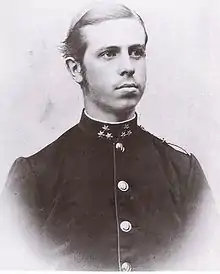Archduke Johann Salvator of Austria
Archduke Johann Salvator of Austria (German: Johann Salvator, Italian: Giovanni Salvatore; 25 November 1852 – declared dead in absentia 2 February 1911) was a member of the Tuscan branch of the House of Habsburg-Lorraine. He was Archduke and Prince of Austria, Prince of Hungary, Bohemia and Tuscany. After renouncing those titles, he was known as Johann (John) Orth. He disappeared while sailing with his wife in July 1890 and is believed to have died when his ship encountered a storm near Cape Horn. Archduke Salvator was declared dead in absentia in February 1911.
| Archduke Johann Salvator | |||||
|---|---|---|---|---|---|
 | |||||
| Born | 25 November 1852 Florence, Grand Duchy of Tuscany | ||||
| Spouse |
Ludmilla ("Milli") Stubel
(m. 1889–1890) | ||||
| |||||
| House | House of Habsburg-Lorraine | ||||
| Father | Leopold II, Grand Duke of Tuscany | ||||
| Mother | Princess Maria Antonia of the Two Sicilies | ||||
| Religion | Roman Catholic | ||||
| Disappeared | c. 12 July 1890 (aged 37) Cape Horn (presumed) | ||||
| Status | Declared dead in absentia on 2 February 1911 | ||||
Early life
Archduke Johann Salvator was born in Florence, the youngest son of Leopold II, Grand Duke of Tuscany and his second wife, Princess Maria Antonia of the Two Sicilies. He was baptized in Florence's Battistero di San Giovanni as Giovanni Nepomuceno Maria Annunziata Giuseppe Giovanni Batista Ferdinando Baldassare Luigi Gonzaga Pietro Alessandrino Zanobi Antonino.[1] He pursued a career in the Austrian Army and was a good friend of Rudolf, Crown Prince of Austria, with both sharing liberal opinions.[2]
After Bulgaria was granted autonomy by the Ottoman Empire, Johann Salvator was an unsuccessful candidate for the throne.[3] Prince Alexander of Battenberg would be elected Prince of Bulgaria in 1879. During the Austro-Hungarian occupation of the Ottoman territory of Bosnia and Herzegovina in 1878, he was put in command of a division of the occupying army and won numerous honours.[4][5]
On 16 October 1889, he resigned his army commission and renounced his title and the privileges he enjoyed as a member of the Austrian Imperial Family.[6] After renouncing his titles he assumed the name "Johann (or John) Orth", the surname Orth derived from the name of a castle he had owned, Schloss Orth.
Disappearance
In 1889, Johann Salvator married Ludmilla ("Milli") Stubel, an opera dancer in London.[7] Shortly after his marriage, he purchased a ship named the Santa Margareta, on which he and his wife sailed for South America. In February 1890 he set off from Montevideo, Uruguay, heading for Valparaíso in Chile.[8] He was last seen on 12 July in Cape Tres Puntas, Argentina. It is believed that his ship was lost during a storm off the coast of Cape Horn.[9] He was officially declared dead on 2 February 1911 in Vienna.[10][11] His possessions were disposed of in 1912.[12]
In the years following Salvator's disappearance, numerous sightings of him were reported. Rumors persisted that he and his wife sailed to South America and assumed new identities.[2] Several men also came forward claiming to be the "missing Duke". One of the more publicised claims came in May 1945 when a German born lithographer living in Kristiansand, Norway named Alexander Hugo Køhler made a deathbed confession claiming that he was Johann Salvator. Køhler claimed that, as Johann Orth, he "bought" the identity of Alexander Hugo Køhler and assumed his life. Køhler claimed that the real Alexander Hugo Køhler posed as Salvator and it was he who died at sea.[13]
Films about the Johann Orth mystery
- Das Geheimnis der Santa Margherita (dir. Rolf Randolf, 1921)
- A Vanished World (dir. Alexander Korda, 1922)
- The Secret of Johann Orth (dir. Willi Wolff, 1932)
- The Red Prince (dir. Hans Schott-Schöbinger, 1954)
References
- "Photography of baptismal register on 1852, 26th November". Retrieved 7 September 2012.
- Fanthorpe, Lionel; Patricia Fanthorpe (2004). Unsolved Mysteries of the Sea. Dundurn Press Ltd. pp. 161–162. ISBN 978-1-55002-498-2.
- Barkeley, Richard (1959). The Road to Mayerling: Life and Death of Crown Prince Rudolph of Austria. Macmillan. p. 158.
- "Europe's Latest Treaty". New York Times. 24 July 1878. p. 1.
- "Orth Officially Dead". New York Times. 28 May 1911. p. 1.
- Almanach de Gotha. Justus Perthes. 1891. p. 12.
- "Johann Orth: Habsburg (ret'd)". habsburger.net. Retrieved 28 July 2015.
- "The Missing Archduke". New York Times. 26 December 1890. p. 1.
- "Will Be Declared Dead". The Milwaukee Sentinel. Milwaukee, Wisconsin. 26 February 1911. p. 1. Retrieved 28 July 2015.
- "John Orth Declared Dead". The Gazette Times. Pittsburgh, Pennsylvania. 2 February 1911. p. 1. Retrieved 28 July 2015.
- Gies McGuigan, Dorothy (1966). The Habsburgs. Doubleday. p. 381.
- "JOHANN ORTH". Sunday Times. No. 1387. New South Wales, Australia. 18 August 1912. p. 23. Retrieved 2 December 2022 – via National Library of Australia.
- "Alexander Hugo Köhler - German lithographer or Italian Archduke?" (in Norwegian). da2.uib.no. April 2008. Archived from the original on 3 January 2016. Retrieved 28 July 2015.